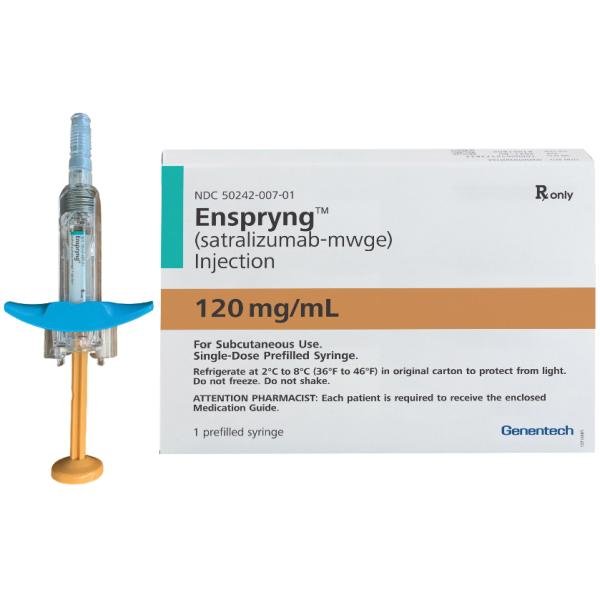Satralizumab Side Effects
Medically reviewed by Drugs.com. Last updated on Nov 13, 2024.
Applies to satralizumab: subcutaneous solution.
Precautions
It is very important that your doctor check your progress at regular visits to make sure this medicine is working properly. Blood tests may be needed to check for unwanted effects.
This medicine can temporarily lower the number of white blood cells and antibodies in your blood, increasing the chance of getting an infection. If you can, avoid people with infections. Check with your doctor immediately if you think you are getting an infection or if you get a fever, chills, cough or hoarseness, lower back or side pain, or painful or difficult urination.
This medicine may cause hepatitis B virus reactivation. Check with your doctor right away if you have any symptoms of liver problems, such as yellow skin or eyes, dark brown-colored urine, right-sided stomach pain, fever, or severe tiredness.
You will need to have a skin test for tuberculosis before you start receiving this medicine. Tell your doctor if you or anyone in your home has ever had a positive reaction to a tuberculosis skin test.
Do not have any live vaccines (immunizations) while you are being treated with satralizumab-mwge injection. You should have completed any needed immunizations at least 4 weeks for live or live-attenuated vaccines and at least 2 weeks for non-live (inactivated) vaccines before starting treatment with this medicine. Check with your doctor before having any vaccines.
Satralizumab-mwge injection may cause serious allergic reactions, including anaphylaxis. Check with your doctor right away if you have a rash, hives, itching, hoarseness, trouble breathing, trouble swallowing, or any swelling of your hands, face, or mouth after using this medicine.
Serious side effects of satralizumab
Along with its needed effects, satralizumab may cause some unwanted effects. Although not all of these side effects may occur, if they do occur they may need medical attention.
Check with your doctor immediately if any of the following side effects occur while taking satralizumab:
More common side effects
- black, tarry stools
- body aches or pain
- burning feeling in the chest or stomach
- chills
- cough
- dark urine
- depression
- difficulty in moving
- dryness or soreness of the throat
- ear congestion
- falls
- fever
- headache
- hoarseness
- indigestion
- joint pain
- light-colored stools
- loss of voice
- lower back or side pain
- muscle pain or stiffness
- nausea and vomiting
- painful or difficult urination
- pain, redness, swelling, tenderness, or warmth on the skin
- pale skin
- skin rash, hives, itching
- sneezing
- sore throat
- stomach upset
- stuffy or runny nose
- tenderness in the stomach area
- tender, swollen glands in the neck
- trouble breathing or swallowing
- ulcers, sores, or white spots in the mouth
- unusual bleeding or bruising
- unusual tiredness or weakness
- upper right stomach pain
- weight gain
- yellow eyes and skin
Other side effects of satralizumab
Some side effects of satralizumab may occur that usually do not need medical attention. These side effects may go away during treatment as your body adjusts to the medicine. Also, your health care professional may be able to tell you about ways to prevent or reduce some of these side effects.
Check with your health care professional if any of the following side effects continue or are bothersome or if you have any questions about them:
More common side effects
- bleeding, blistering, burning, coldness, discoloration of the skin, feeling of pressure, hives, infection, inflammation, itching, lumps, numbness, pain, rash, redness, scarring, soreness, stinging, swelling, tenderness, tingling, ulceration, or warmth at the injection site
See also:
For healthcare professionals
Applies to satralizumab: subcutaneous solution.
General adverse events
The most common adverse reactions (15% or greater) were nasopharyngitis, headache, upper respiratory tract infection, gastritis, rash, arthralgia, extremity pain, fatigue, and nausea.[Ref]
Immunologic
- Very common (10% or more): Cellulitis (10%)
- Frequency not reported: Potential for immunogenicity[Ref]
Local
- Frequency not reported: Injection site reaction, skin mass[Ref]
Musculoskeletal
- Very common (10% or more): Arthralgia (17%), pain in extremity (15%)[Ref]
Metabolic
- Very common (10% or more): Weight gain (30%), cholesterol increased (15%)[Ref]
Psychiatric
- Very common (10% or more): Depression (10%)[Ref]
Hepatic
- Very common (10% or more): Fibrinogen levels increased (38%), ALT and AST elevated (43%)[Ref]
Respiratory
- Very common (10% or more): Nasopharyngitis (31%), upper respiratory tract infection (19%), pharyngitis (12%)[Ref]
Other
Hematologic
- Very common (10% or more): Neutropenia (10%), blood creatine phosphokinase[Ref]
Nervous system
- Very common (10% or more): Headache (27%)[Ref]
Dermatologic
Gastrointestinal
- Very common (10% or more): Gastritis (15%), nausea (15%)[Ref]
References
1. (2020) "Product Information. Enspryng (satralizumab)." Genentech
More about satralizumab
- Check interactions
- Compare alternatives
- Dosage information
- During pregnancy
- Drug class: interleukin inhibitors
- Breastfeeding
- En español
Patient resources
Other brands
Professional resources
Other brands
Related treatment guides
Further information
Satralizumab side effects can vary depending on the individual. Always consult your healthcare provider to ensure the information displayed on this page applies to your personal circumstances.
Note: Medication side effects may be underreported. If you are experiencing side effects that are not listed, submit a report to the FDA by following this guide.

